浅析中国茶文化及茶产品的英文翻译
- 格式:pdf
- 大小:212.46 KB
- 文档页数:2
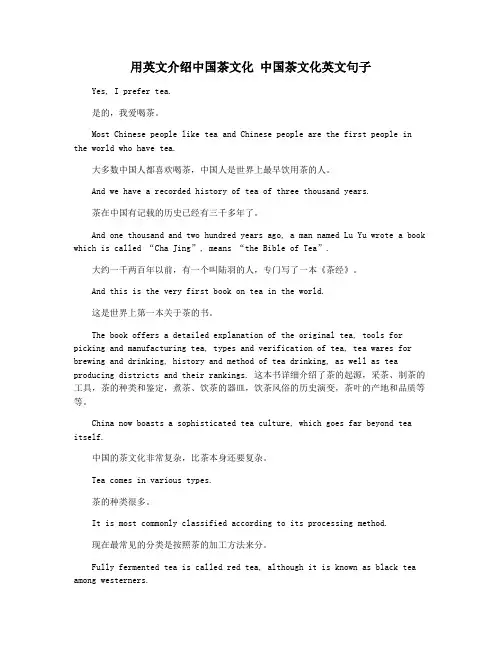
用英文介绍中国茶文化中国茶文化英文句子Yes, I prefer tea.是的,我爱喝茶。
Most Chinese people like tea and Chinese people are the first people in the world who have tea.大多数中国人都喜欢喝茶,中国人是世界上最早饮用茶的人。
And we have a recorded history of tea of three thousand years.茶在中国有记载的历史已经有三千多年了。
And one thousand and two hundred years ago, a man named Lu Yu wrote a book which is called “Cha Jing”, means “the Bible of Tea”.大约一千两百年以前,有一个叫陆羽的人,专门写了一本《茶经》。
And this is the very first book on tea in the world.这是世界上第一本关于茶的书。
The book offers a detailed explanation of the original tea, tools for picking and manufacturing tea, types and verification of tea, tea wares for brewing and drinking, history and method of tea drinking, as well as tea producing districts and their rankings. 这本书详细介绍了茶的起源,采茶、制茶的工具,茶的种类和鉴定,煮茶、饮茶的器皿,饮茶风俗的历史演变,茶叶的产地和品质等等。
China now boasts a sophisticated tea culture, which goes far beyond tea itself.中国的茶文化非常复杂,比茶本身还要复杂。

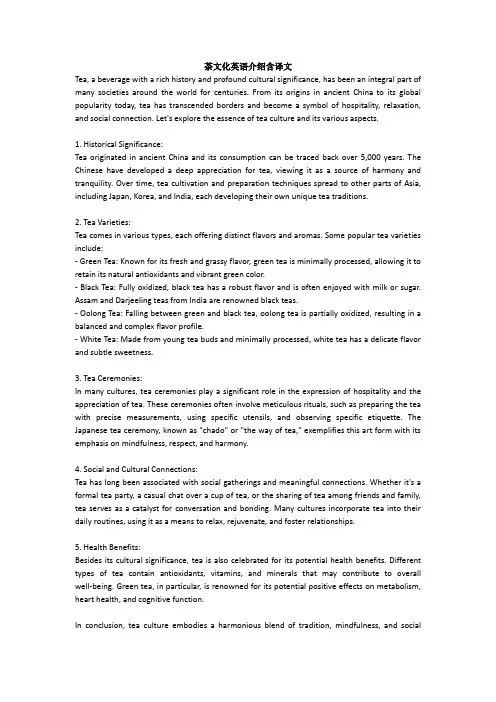
茶文化英语介绍含译文Tea, a beverage with a rich history and profound cultural significance, has been an integral part of many societies around the world for centuries. From its origins in ancient China to its global popularity today, tea has transcended borders and become a symbol of hospitality, relaxation, and social connection. Let's explore the essence of tea culture and its various aspects.1. Historical Significance:Tea originated in ancient China and its consumption can be traced back over 5,000 years. The Chinese have developed a deep appreciation for tea, viewing it as a source of harmony and tranquility. Over time, tea cultivation and preparation techniques spread to other parts of Asia, including Japan, Korea, and India, each developing their own unique tea traditions.2. Tea Varieties:Tea comes in various types, each offering distinct flavors and aromas. Some popular tea varieties include:- Green Tea: Known for its fresh and grassy flavor, green tea is minimally processed, allowing it to retain its natural antioxidants and vibrant green color.- Black Tea: Fully oxidized, black tea has a robust flavor and is often enjoyed with milk or sugar. Assam and Darjeeling teas from India are renowned black teas.- Oolong Tea: Falling between green and black tea, oolong tea is partially oxidized, resulting in a balanced and complex flavor profile.- White Tea: Made from young tea buds and minimally processed, white tea has a delicate flavor and subtle sweetness.3. Tea Ceremonies:In many cultures, tea ceremonies play a significant role in the expression of hospitality and the appreciation of tea. These ceremonies often involve meticulous rituals, such as preparing the tea with precise measurements, using specific utensils, and observing specific etiquette. The Japanese tea ceremony, known as "chado" or "the way of tea," exemplifies this art form with its emphasis on mindfulness, respect, and harmony.4. Social and Cultural Connections:Tea has long been associated with social gatherings and meaningful connections. Whether it's a formal tea party, a casual chat over a cup of tea, or the sharing of tea among friends and family, tea serves as a catalyst for conversation and bonding. Many cultures incorporate tea into their daily routines, using it as a means to relax, rejuvenate, and foster relationships.5. Health Benefits:Besides its cultural significance, tea is also celebrated for its potential health benefits. Different types of tea contain antioxidants, vitamins, and minerals that may contribute to overall well-being. Green tea, in particular, is renowned for its potential positive effects on metabolism, heart health, and cognitive function.In conclusion, tea culture embodies a harmonious blend of tradition, mindfulness, and socialconnection. With its diverse varieties, meaningful ceremonies, and health benefits, tea continues to be cherished and enjoyed by people from various cultures worldwide. Whether you're sipping a soothing cup of green tea or participating in an elaborate tea ceremony, tea invites us to appreciate the simple joys of life and embrace moments of tranquility.译文:茶是一种具有悠久历史和深厚文化意义的饮料,几个世纪以来一直是世界各地许多社会不可或缺的一部分。
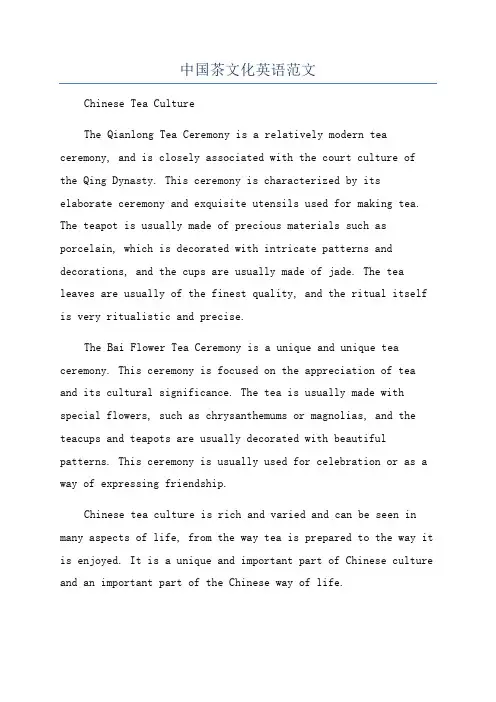
中国茶文化英语范文Chinese Tea CultureThe Qianlong Tea Ceremony is a relatively modern tea ceremony, and is closely associated with the court culture of the Qing Dynasty. This ceremony is characterized by its elaborate ceremony and exquisite utensils used for making tea. The teapot is usually made of precious materials such as porcelain, which is decorated with intricate patterns and decorations, and the cups are usually made of jade. The tea leaves are usually of the finest quality, and the ritual itself is very ritualistic and precise.The Bai Flower Tea Ceremony is a unique and unique tea ceremony. This ceremony is focused on the appreciation of tea and its cultural significance. The tea is usually made with special flowers, such as chrysanthemums or magnolias, and the teacups and teapots are usually decorated with beautiful patterns. This ceremony is usually used for celebration or as a way of expressing friendship.Chinese tea culture is rich and varied and can be seen in many aspects of life, from the way tea is prepared to the way it is enjoyed. It is a unique and important part of Chinese culture and an important part of the Chinese way of life.。
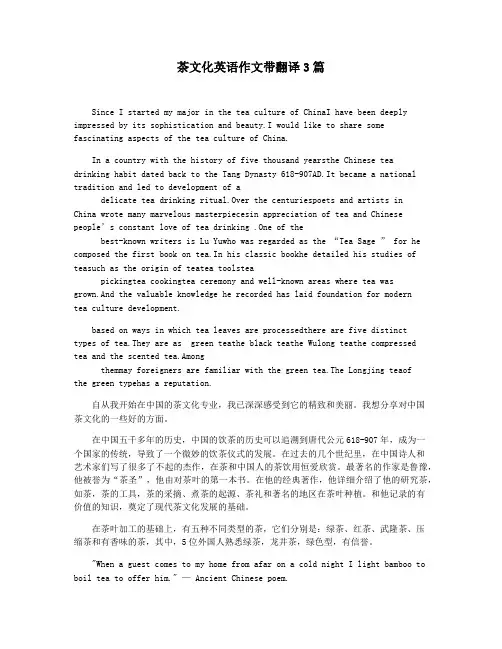
茶文化英语作文带翻译3篇Since I started my major in the tea culture of ChinaI have been deeply impressed by its sophistication and beauty.I would like to share some fascinating aspects of the tea culture of China.In a country with the history of five thousand yearsthe Chinese teadrinking habit dated back to the Tang Dynasty 618-907AD.It became a national tradition and led to development of adelicate tea drinking ritual.Over the centuriespoets and artists inChina wrote many marvelous masterpiecesin appreciation of tea and Chinese people’s constant love of tea drinking .One of thebest-known writers is Lu Yuwho was regarded as the “Tea Sage ” for he composed the first book on tea.In his classic bookhe detailed his studies of teasuch as the origin of teatea toolsteapickingtea cookingtea ceremony and well-known areas where tea wasgrown.And the valuable knowledge he recorded has laid foundation for moderntea culture development.based on ways in which tea leaves are processedthere are five distincttypes of tea.They are as green teathe black teathe Wulong teathe compressedtea and the scented tea.Amongthemmay foreigners are familiar with the green tea.The Longjing teaofthe green typehas a reputation.自从我开始在中国的茶文化专业,我已深深感受到它的精致和美丽。
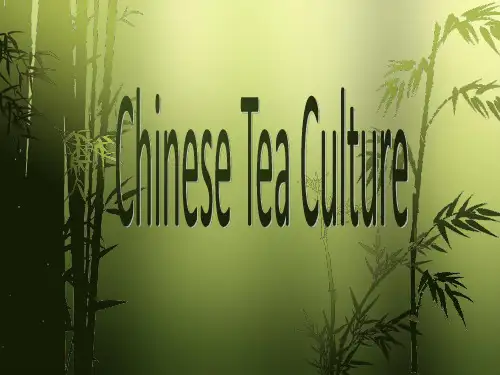
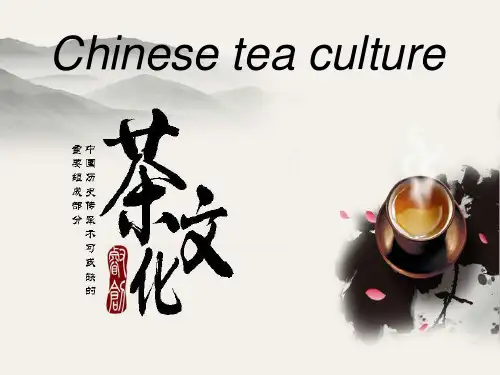
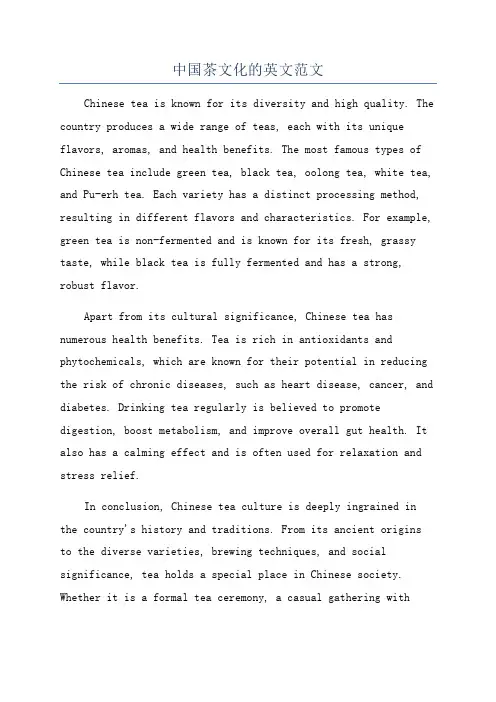
中国茶文化的英文范文Chinese tea is known for its diversity and high quality. The country produces a wide range of teas, each with its unique flavors, aromas, and health benefits. The most famous types of Chinese tea include green tea, black tea, oolong tea, white tea, and Pu-erh tea. Each variety has a distinct processing method, resulting in different flavors and characteristics. For example, green tea is non-fermented and is known for its fresh, grassy taste, while black tea is fully fermented and has a strong, robust flavor.Apart from its cultural significance, Chinese tea has numerous health benefits. Tea is rich in antioxidants and phytochemicals, which are known for their potential in reducing the risk of chronic diseases, such as heart disease, cancer, and diabetes. Drinking tea regularly is believed to promote digestion, boost metabolism, and improve overall gut health. It also has a calming effect and is often used for relaxation and stress relief.In conclusion, Chinese tea culture is deeply ingrained in the country's history and traditions. From its ancient originsto the diverse varieties, brewing techniques, and social significance, tea holds a special place in Chinese society. Whether it is a formal tea ceremony, a casual gathering withfriends, or a quiet moment alone, tea serves as a reminder of the values of harmony, respect, and well-being.。
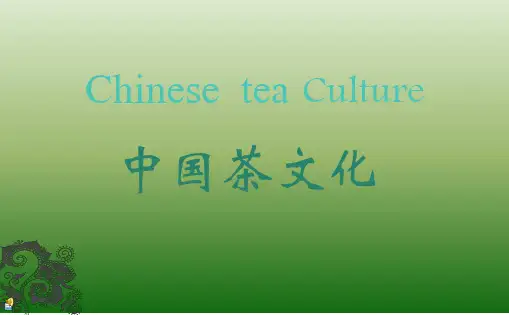
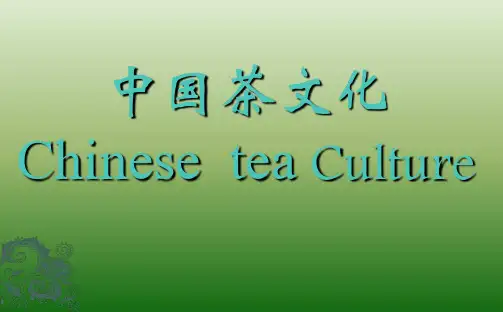
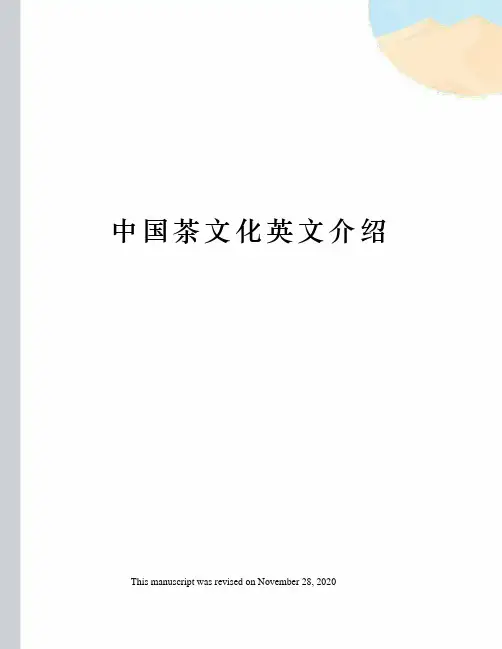
中国茶文化英文介绍 This manuscript was revised on November 28, 2020中国茶文化英文介绍The Chinese people, in their drinking of tea, place much significance on the act of "savoring." "Savoring tea" is not only a way to discern good tea from mediocre tea, but also how people take delight in their reverie and intea-drinking itself. Snatching a bit of leisure from a busy schedule, making a kettle of strong tea, securing a serene space, and serving and drinking tea by yourself can help banish fatigue and frustration, improve your thinking ability and inspire you with enthusiasm. You may also imbibe it slowly in small sips to appreciate the subtle allure of tea-drinking, until your spirits soar up and up into a sublime aesthetic realm. Buildings, gardens, ornaments and tea sets are the elements that form the ambience for savoring tea. A tranquil, refreshing, comfortable and neat locale is certainly desirable for drinking tea. Chinese gardens are well known in the world and beautiful Chinese landscapes are too numerous to count. Teahouses tucked away in gardens and nestled beside the natural beauty of mountains and rivers are enchanting places of repose for people to rest and recreate themselves.China is a country with a time-honored civilization and a land of ceremony and decorum. Whenever guests visit, it is necessary to make and serve tea to them. Before serving tea, you may ask them for their preferences as to what kind of tea they fancy and serve them the tea in the most appropriate teacups. In the course of serving tea, the host should take careful note of how much water is remaining in the cups and in the kettle. Usually, if the tea is made in a teacup, boiling water should be added after half of the cup has been consumed; and thus the cup is kept filled so that the tea retains the same bouquet and remains pleasantly warm throughout the entire course of tea-drinking. Snacks, sweets and other dishes may be served at tea time to complement the fragrance of the tea and to al lay one’s hunger.参考译文:中国人饮茶,注重一个"品"字。
关于中国茶文化的英语作文带翻译关于中国茶文化的英语作文带翻译篇一:中国茶文化In China, tea has a very long history, and has formed a Chinese tea culture. At the same time, tea is good for our health and is loved by many people. Chinese tea culture is broad and profound. It includes not only material culture, but also profound spiritual civilization. Talking about Chinese tea. Can be traced back to ancient times, it is from the Tang Dynasty and Song Dynasty flourished.From then on, the spirit of tea permeated the court and society, and went deep into Chinese poetry, painting, calligraphy, religion and medicine. For thousands of years, China has accumulated a large number of tea cultivation and production of material culture, but also enriched the spiritual culture of tea.【参考译文】在中国,茶具有非常悠久的历史,并且已经形成了中国茶文化。
与此同时,茶有益于我们的健康,因此受到许多人的喜爱。
中国茶文化博大精深,不但包含物质文化层面,还包含深厚的精神文明层面。
英文写作茶文化附中文翻译Tea has been an integral part of various cultures around the world for centuries. From its origins in ancient China to its widespread popularity today, tea has not only become a beverage but also a symbol of elegance, tranquility, and hospitality. Let's explore the rich and diverse world of tea culture.Chinese tea culture, with a history dating back thousands of years, is renowned for its profound influence on other tea-drinking countries. In China, tea is not simply a drink but an art form. The preparation and serving of tea involve intricate rituals designed to enhance the appreciation of its taste, aroma, and aesthetic beauty. Chinese tea ceremonies often emphasize harmony, respect, and mindfulness, creating a serene and contemplative atmosphere.Japanese tea culture, heavily influenced by Chinese traditions, has developed its own unique practices. The Japanese tea ceremony, known as "chanoyu" or "sado," emphasizes simplicity, tranquility, and the appreciation of nature. Matcha, a finely powdered green tea, is the centerpiece of the Japanese tea ceremony. The process ofpreparing and serving matcha involves precise movements and gestures, showcasing the beauty of minimalism and attention to detail.In India, tea holds a significant cultural and social importance. Masala chai, a spiced tea blend, is a popular choice in Indian households. Tea is not only enjoyed as a refreshing beverage but also serves as a catalyst for social gatherings and discussions. The concept of "chai pe charcha," meaning "tea and conversation," reflects the role of tea as a facilitator of connections and conversations among people.Tea culture is not limited to East Asia and India. In the United Kingdom, the tradition of afternoon tea holds a special place. It is a cherished ritual that typically involves tea served with scones, finger sandwiches, and pastries. The British take pride in their tea etiquette, with proper teapot pouring techniques and the use of fine china.No matter where tea culture is embraced, it promotes a sense of relaxation, mindfulness, and social interaction. Whether it is a formal ceremony or a casual gathering with friends, tea offers a moment of pause in our busy lives,allowing us to appreciate the simple pleasures and connect with others.中文翻译为:茶在世界各地的文化中已经有数百年的历史,它不仅成为一种饮料,更是优雅、宁静和热情待客的象征。
茶文化和茶道的英文翻译中国茶文化是中国制茶、饮茶的文化。
下面是店铺精心为你整理的茶文化和茶道的英文翻译,一起来看看。
茶文化和茶道的英文翻译茶文化tea culture茶道teaism; tea ceremony ;中国茶文化Chinese Tea Culture英国茶文化British Tea Culture茶文化的功能茶文化的社会功能主要表现在发扬茶德、传播茶道、文化艺术、修身养性、陶冶情操、促进民族团结、表现社会进步和发展经济贸易等。
茶德是经过几千年积淀下来的被历代人们所推崇的茶内在具备的美好品性。
茶文化具有的传统主要有热爱祖国、无私奉献、坚韧不拔、谦虚礼貌、勤奋节俭和相敬互让等。
吴觉农先生和湖南刘先和,为茶叶事业鞠躬尽瘁,既是爱国主义者,又是当代茶人杰出代表。
陆羽《茶经》,是古代茶人勤奋读书、刻苦学习、潜心求索、百折不挠精神的结晶。
以茶待客、以茶代酒,“清茶一杯也醉人”就是汉民族珍惜劳动成果、勤奋节俭的真实反映。
以茶字当头排列茶文化的社会功能有“以茶思源、以茶待客、以茶会友、以茶联谊、以茶廉政、以茶育人、以茶代酒、以茶健身、以茶入诗、以茶入艺、以茶入画、以茶起舞、以茶歌呤、以茶兴文、以茶作礼、以茶兴农、以茶促贸和以茶致富。
茶是中国的骄傲、民族的自尊、自信和自豪。
饮茶可以思源。
世界著名科技史家李约瑟博士,将中国茶叶作为中国四大发明(火药、造纸、指南针和印刷术)之后,对人类的第五个重大贡献。
唐代陆羽《茶经》是世界第一部茶书。
中国茶文化对世界影响功能显著。
以茶会友是茶文化最广泛的社会功能之一。
今天所处的市场经济,竞争激烈,优胜劣汰,讲利益、讲效益。
但人情较为冷漠,人际关系趋于淡漠。
通过茶楼、茶艺馆品茗或茶艺,朋友聚在一起,互通信息,交流感情,增进了解,沟通友谊。
朋友相聚在旧式茶馆里,随意说笑,回忆人生,重新享受到生命的乐趣。
古代就有“寒夜客来茶当酒”之说,以茶代酒体现传统美德,符合今天中央倡导的厉行节约制止奢侈浪费行为的规定要求。
竭诚为您提供优质的服务,优质的文档,谢谢阅读/双击去除用英文简介中国茶文化 [中国茶文化的英文介绍]中国擦痕恶化博大精深,那你们知道中国茶文化的英文介绍吗?下面是小编精心为你整理的中国茶文化的英文介绍,一起来看看。
中国茶文化的英文介绍Thechinesepeople,intheirdrinkingoftea,placemuchsignificanceontheactof"savoring.""savoringtea"isnotonly awaytodiscerngoodteafrommediocretea,butalsohowpeopl etakedelightintheirreverieandintea-drinkingitself.s natchingabitofleisurefromabusyschedule,makingakettl eofstrongtea,securingaserenespace,andservinganddrin kingteabyyourselfcanhelpbanishfatigueandfrustration ,improveyourthinkingabilityandinspireyouwithenthusi asm.youmayalsoimbibeitslowlyinsmallsipstoappreciate thesubtleallureoftea-drinking,untilyourspiritssoaru pandupintoasublimeaestheticrealm.buildings,gardens, ornamentsandteasetsaretheelementsthatformtheambienc eforsavoringtea.Atranquil,refreshing,comfortableand neatlocaleiscertainlydesirablefordrinkingtea.chines egardensarewellknownintheworldandbeautifulchinesela ndscapesaretoonumeroustocount.Teahousestuckedawayin gardensandnestledbesidethenaturalbeautyofmountainsa ndriversareenchantingplacesofreposeforpeopletoresta ndrecreatethemselves.chinaisacountrywithatime-honoredcivilizationandalandofceremonyanddecorum.wheneverguestsvisit,itisneces sarytomakeandserveteatothem.beforeservingtea,youmay askthemfortheirpreferencesastowhatkindofteatheyfanc yandservethemtheteainthemostappropriateteacups.Inth ecourseofservingtea,thehostshouldtakecarefulnoteofh ual ly,iftheteaismadeinateacup,boilingwatershouldbeadde dafterhalfofthecuphasbeenconsumed;andthusthecupiske ptfilledsothatthetearetainsthesamebouquetandremains pleasantlywarmthroughouttheentirecourseoftea-drinki ng.snacks,sweetsandotherdishesmaybeservedatteatimet ocomplementthefragranceoftheteaandtoallayone'shunge r.中国人饮茶,注重一个"品"字。